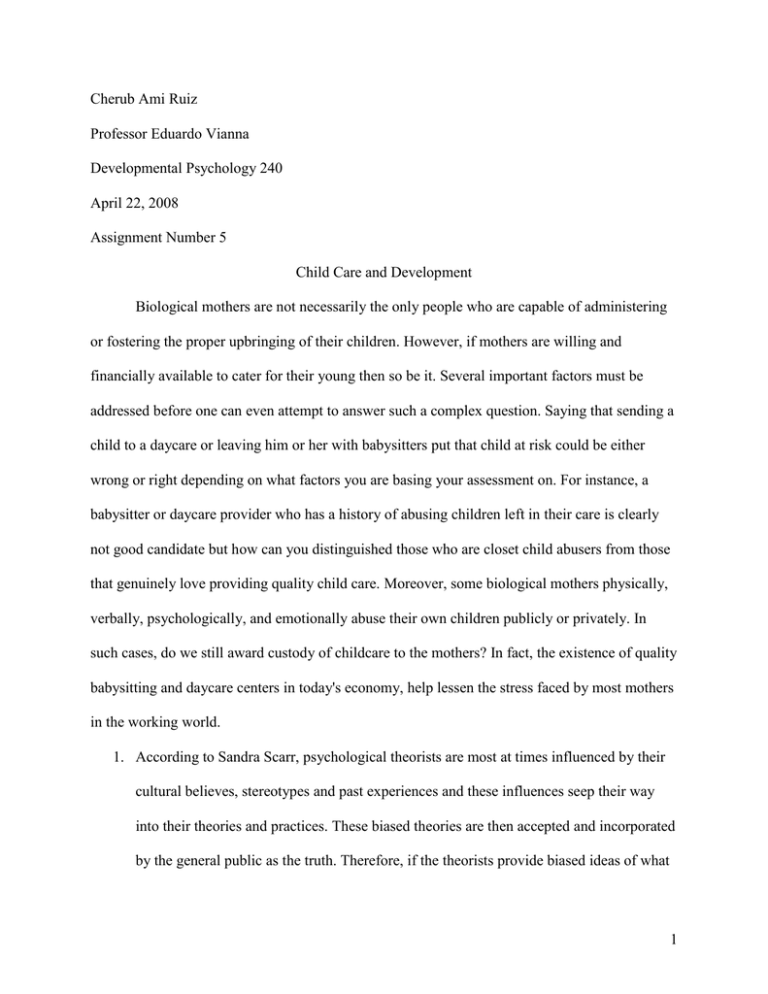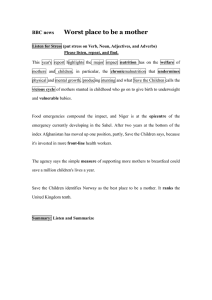Cherub Ami Ruiz Professor Eduardo Vianna Developmental Psychology 240 April 22, 2008
advertisement

Cherub Ami Ruiz Professor Eduardo Vianna Developmental Psychology 240 April 22, 2008 Assignment Number 5 Child Care and Development Biological mothers are not necessarily the only people who are capable of administering or fostering the proper upbringing of their children. However, if mothers are willing and financially available to cater for their young then so be it. Several important factors must be addressed before one can even attempt to answer such a complex question. Saying that sending a child to a daycare or leaving him or her with babysitters put that child at risk could be either wrong or right depending on what factors you are basing your assessment on. For instance, a babysitter or daycare provider who has a history of abusing children left in their care is clearly not good candidate but how can you distinguished those who are closet child abusers from those that genuinely love providing quality child care. Moreover, some biological mothers physically, verbally, psychologically, and emotionally abuse their own children publicly or privately. In such cases, do we still award custody of childcare to the mothers? In fact, the existence of quality babysitting and daycare centers in today's economy, help lessen the stress faced by most mothers in the working world. 1. According to Sandra Scarr, psychological theorists are most at times influenced by their cultural believes, stereotypes and past experiences and these influences seep their way into their theories and practices. These biased theories are then accepted and incorporated by the general public as the truth. Therefore, if the theorists provide biased ideas of what 1 the role of child care is, we the public buy this and implement policies that fight against child care providers and limit their resources for existence. 2. The fantasies constructed by psychologists pertaining to the roles of mothers in infant development according to Sandra Scarr are as follows; a. The idea that single relationship between mothers and their infants is very crucial for providing adequate physical and nourishment for their children. b. the fact that the infants suffer from maternal deprivation which causes the child to develop into a irresponsible, wayward adult. c. the fact that early experience such as the development of secure attachment with mothers during infancy leads to later development such as the development of secure with others during adulthood. 3. Scarr critique certain research programs for contributing to these fantasies. These programs include research literature, early attachment research, social development studies and intellectual and cognitive development programs. 4. She invoke that these alternative programs should be considered when dealing with these problems: Seeing child care as a heterogeneous environment, considering the relationship between the home and child care and the quality of care provided by both. the context in which families use child care services, the effects of the unavailability of quality child care, the need to identify and distinguished which effects of child care are transitory and which are long lasting. 5. The reason provided in chapter 6 as to why children develop similar attachments as with their mothers is because they provided similar care such as holding, kissing and touching during the critical stage in their infancy. Another reason for children attachments with others such as peers, siblings, grandparents and others are due to overexposure and 2 familiarization to these people. However, the more time one spends with the children and care for them, the stronger the attachments developed. The culture of the family also plays a key role in type of attachment that is formed with either mom or dad. For instance, American father’s attachments to their child are solely dependent on the supportiveness of the mother of that child. Another reason was provided in the table 6.2 of chapter 6, in this, four peers of similar dark background who are also casualties of war, developed a protective attachment with each other as a survival tactics to ensure each others safety, security and happiness. 6. It sheds more light on the fact that children do not necessarily need or depend on their mothers for survival. Therefore, the believe that children suffer from maternal deprivation is only to limit and confine mothers to child rearing duties. It also fails to consider the actual quality times working mothers spend with their children when they are not at work. It also contributes to the increase in cost of living by restricting mothers from participating in the working world. It also neglects to consider the role that different cultures play in child rearing. 7. Early experience allow or permit early attachments to develop but does not mean that what ever type of early attachment developed will be the determining factor for what type of adult during late development. In this case, continuity does not foster inevitability. According to chapter 6, page 255, significant steadiness of attachment is established from one type period to the next. However, that stability is liable to change also. For instance, an infant who was insecurely attached is likely to grow into a secure adult based on future interactions and experiences. Thus, as one grows, one construct, adjust or adapt his or her 3 lifestyle based on several interactions so as to foster individual security, happiness and societal acceptability within a given environment. 8. Differences in child care arrangements affect child development can either improve or disrupting the child’s development. Research on group size provided that the smaller the group size the more one on one interaction between the care provider and the individual students, thus more social, and education is fostered. However, if the group size is too big more management is required, the child per care giver is reduced substantially which may lead to inadequate language, social and cognitive development. Researchers also found out that care centers usually employ good care givers who are more in synch with the child’s mood and respond accordingly. 9. Home care does not equal good care because it keeps the child away from associating with other peers, it also limits him or her from possibly becoming an independent individual who has develop both socially and cognitively. 10. Research findings show that the quality of time spent by both employed and stay at home mothers roughly evens out. This is so, cause most stay at home mothers are not only limited to child caring but to other household chores such as cleaning, cooking, paying bills, personal time and caring for other people as well. Therefore, even though, it may appear that stay at mothers spend more time with their kids, the reality might be quite different. On the other hand, most working mothers spend their time building lasting relationship with their child within their short time span. They spend most of their off days attending to their children’s needs and wants. 11. Personally, I do not think a straight answer can be drawn for these questions. However, in order for one to provide a fair and unambiguous answers, one must put aside one 4 traditional difference and truly consider what will happen if there was no quality daycare or babysitters. How efficient is home care and how well do they cater for the child’s physical, psychological, cognitive and social wellbeing. The roles of mothers in different cultures, the temperament of the child and that of the care provider. It will also require the researcher to pay critical attention to the mood swings of care providers either at home or at the daycare toward the child on a daily bases. 12. A good day care is one that put the overall wellbeing of the child over their own. It is a home away from home where the child feels secure enough to explore new environment and to develop both cognitively and socially. It also provides the care and attention to children who lack these special treatments at their various homes. A good daycare also strives to work together with parents in order to ensure excellent child development for the greater good of the child. It also provide safe and secure child friendly environment for the child in its care. It also employs top notch, well qualified care providers who are capable of adjusting their moods to that of the child and react accordingly to build stable relationships with the child. It must also be stable, reliable and affordable in that parents will not hesitate to leave their children in their care. 5


